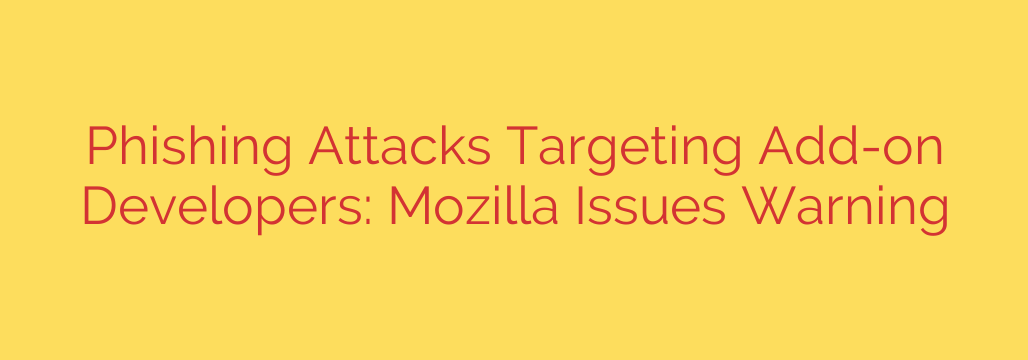
Developers Beware: Sophisticated Phishing Attacks Are Targeting Your Browser Extensions
A new wave of highly targeted phishing attacks is putting browser extension and add-on developers in the crosshairs. Cybercriminals are increasingly focused on a high-value target: the developer accounts that control add-ons used by millions of people. A successful attack doesn’t just compromise one person; it can turn a trusted browser extension into a powerful tool for distributing malware, stealing user data, and spying on web activity.
If you are a developer, the security of your creations—and your users—depends on your ability to recognize and defend against these evolving threats.
How the Scam Works: A Deceptive Strategy
These phishing campaigns are not your average spam. Attackers are crafting convincing emails that appear to be official security alerts from legitimate platforms, such as the Mozilla Add-ons (AMO) or Chrome Web Store teams.
The typical attack follows a familiar but effective pattern:
- The Bait: The developer receives an email warning them of a security issue with their add-on or a new policy violation that requires immediate action.
- The Urgency: The message uses urgent and threatening language, suggesting their add-on will be removed or their account suspended if they don’t act quickly.
- The Trap: The email contains a link that directs them to a fake login page. This counterfeit page is designed to look identical to the official developer portal.
- The Heist: The unsuspecting developer enters their username, password, and sometimes even their two-factor authentication (2FA) codes. With these credentials stolen, the attacker gains full control of the developer’s account.
Once they have access, criminals can push a malicious update to the extension. This hijacked add-on then becomes a supply chain attack vector, silently infecting every user who has it installed.
Essential Security Measures for Every Developer
Protecting your developer account from a takeover is not optional—it’s a critical responsibility. The stakes are too high to ignore. Here are the most important steps you must take to secure your accounts and protect your users.
1. Enable Two-Factor Authentication (2FA) Immediately
This is the single most effective defense against credential theft. Even if an attacker steals your password, they cannot access your account without the second factor (a code from your phone, a security key, etc.). Make 2FA mandatory for your developer accounts on all platforms. If you haven’t enabled it yet, stop what you are doing and set it up now.
2. Scrutinize Every Email Requesting Action
Treat all unsolicited emails with suspicion, especially those that demand urgent action or ask for your login credentials. Before clicking any link, ask yourself:
- Is the sender’s email address legitimate? Attackers often use addresses that are slightly misspelled (e.g.,
google-support.cominstead ofgoogle.com). - Does the message create a false sense of urgency? Phrases like “Urgent Security Alert” or “Account Suspension Notice” are red flags.
- Where does the link really go? Hover your mouse over any links before clicking to see the actual destination URL. If it doesn’t match the official domain of the service (e.g.,
addons.mozilla.org), do not click it.
3. Never Enter Credentials After Clicking an Email Link
Get into the habit of bookmarking the official login pages for your developer portals. When you need to log in, use your bookmark or type the URL directly into your browser. This simple practice completely bypasses the risk of landing on a counterfeit phishing site from a malicious email.
4. Use a Unique and Strong Password
Every online account should have its own unique, complex password. Reusing passwords across different services is a massive security risk; if one account is breached, all of them are vulnerable. Use a trusted password manager to generate and store strong, unique passwords for each of your developer accounts.
Your Vigilance is the First Line of Defense
The threat of add-on hijacking is real and growing. As a developer, you are the gatekeeper of your users’ trust and security. By adopting a security-first mindset and implementing these essential protective measures, you can fortify your defenses against sophisticated phishing attacks. Stay vigilant, question every suspicious request, and make robust security practices a core part of your development workflow. The security of the ecosystem depends on it.
Source: https://www.bleepingcomputer.com/news/security/mozilla-warns-of-phishing-attacks-targeting-add-on-developers/








